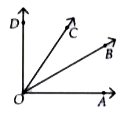Which of the following statements are true (T) and which are false(F) (i) Angles forming a linear pair are supplementary. (ii) If two adjacent angles are equal, then each angle measures 90∘.. (iii) Angles forming a linear pair can both the acute angles. {iv) If angles forming a linear pair are equal, then each of these angles is of measure 90∘..
(i) True.(ii) False. It can be possible if they are a linear pair.(iii)False. In a linear pair, if one is acute, then the other will be obtuse(iv)True.
Similar Questions
Which of the following statements are true (T) and which are false(F) (i) Angles forming a linear pair are supplementary. (ii) If two adjacent angles are equal, then each angle measures 90∘.. (iii) Angles forming a linear pair can both the acute angles. {iv) If angles forming a linear pair are equal, then each of these angles is of measure 90∘..
View SolutionTwo angles forming a __________ pair are supplementary.
View Solution
Knowledge Check
If the angles of a linear pair are equal, then each angle is _____
A30∘B45∘C60∘D90∘If the angles of a linear pair are equal, then each angle is _____
A30∘B45∘C60∘D90∘Which of the following pairs of angles are not adjacent angles?
 A∠AOB,∠BODB∠BOC,∠AOCC∠COD,∠AOCD∠BOC,∠AOB
A∠AOB,∠BODB∠BOC,∠AOCC∠COD,∠AOCD∠BOC,∠AOB
State whether the statements are True or False.
Two angles making a linear pair are always supplementary.
View SolutionOne of the angles forming a linear pair is an acute angle. What kind of angle is the other?
View SolutionCan two acute angles from a linear pair?
View SolutionOne of the angles forming a linear pair is an obtuse angle. What kind of angle is the other?
View SolutionWhich of the following pairs of angles are supplementary ?
View Solution